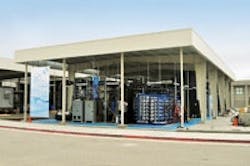Purifying Recycled Water: A Study
Marsi A. Steirer is Water Purification Demonstration Project director for the City of San Diego Public Utilities Department. For more information, contact the City of San Diego Water Purification Demonstration Project at [email protected] or 619.533.7572.
The city of San Diego has launched a year-long test of a new local source of water for the semi-arid city. The Advanced Water Purification Facility is a small-scale, state-of-the-art water purification facility that purifies 1 million gal of recycled water to distilled water quality on a daily basis.
The facility is one component of the city’s Water Purification Demonstration Project, which is examining the safety and cost of purifying recycled water. If this project is approved to go full-scale, a much larger project would produce purified water to blend with the city’s imported supplies at San Vicente Reservoir to become part of the community drinking water supply. As another component of the demonstration project, the city is studying San Vicente Reservoir and the potential effects of adding purified water to it. During the year-long test phase, purified water will not be sent to San Vicente Reservoir or the city’s drinking water system; instead, the purified water will be added to the city’s recycled water system.
Water Supply Diversification
San Diego is testing water purification as a means to develop a locally controlled, supplemental water supply. San Diego’s semi-arid region is at the end of pipelines that import water from hundreds of miles away. The city needs to develop local, reliable water sources to lessen its dependence on expensive and limited imported water supplies.
“Our city has been both creative and aggressive in trying to diversify our water supply. The less we rely on importing water from outside San Diego County, the more we control our own destiny,” said San Diego Mayor Jerry Sanders. “A locally produced supply of water could be an important option for us.”
All wastewater in San Diego undergoes treatment to remove harmful contaminants, making it safe enough to be discharged into the ocean. Some wastewater is diverted to the city’s recycled water facilities, where it is treated further and then used for irrigation and industrial purposes. A portion of the recycled water produced at the North City Water Reclamation Plant will be sent to the Advanced Water Purification Facility.
At the facility, the recycled water undergoes the multibarrier purification process, which includes membrane filtration, reverse osmosis and advanced oxidation with ultraviolet disinfection and high-strength hydrogen peroxide. The multibarrier approach comprises consecutive treatment steps that work together to remove or destroy all unwanted materials in the water and produce one of the most pristine supplies of water available anywhere. Each step in the process includes continuous water quality monitoring. The city thoroughly examines the safety of the water through laboratory tests and computer analysis to ensure that it meets public health standards.
The data from the demonstration project will be examined thoroughly, and the results will determine the safety and cost of a full-scale water purification and reservoir augmentation project. After the test phase is complete, the city council and mayor will decide whether to implement a full-scale project.
“This demonstration project will provide the answers San Diego needs before taking the next step with purified water,” Sanders said. “We owe it to our citizens to see if we can come up with an alternative source of local, safe and relatively inexpensive drinking water.”
The same water purification process already is used around the world. Just north of San Diego, Orange County operates the world’s largest water purification plant. The Orange County Groundwater Replenishment System produces up to 70 million gal per day of ultraclean water to provide safe and reliable drinking water for nearly 600,000 residents. The purified water is produced from secondary-treated wastewater and injected into the county’s drinking water aquifer.
In the Public Eye
Visitors are welcome and encouraged to tour the Advanced Water Purification Facility through Summer 2012. Guests who participate in the tour will gain a better understanding of the demonstration project and what role the facility plays in this testing phase. Following an introductory presentation, participants will take a walking tour through the facility to view the water purification technology equipment up close. At the end of the tour, guests will view the purified water produced at the facility.
To register for a tour, visit www.purewatersd.org/tours.shtml.
For more information about the San Diego Water Purification Demonstration Project, visit www.purewatersd.org.
Download: Here
